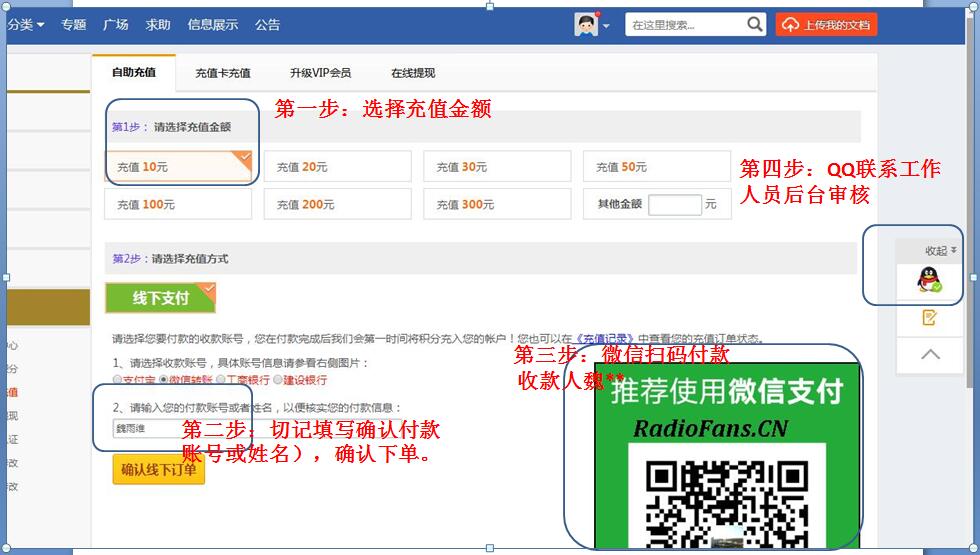 FisherFM190ServiceManual 电路原理图.pdf
FisherFM190ServiceManual 电路原理图.pdf
《FisherFM190ServiceManual 电路原理图.pdf》由会员分享,可在线阅读,更多相关《FisherFM190ServiceManual 电路原理图.pdf(10页珍藏版)》请在收音机爱好者资料库上搜索。
1、Service Manual THEFISHER THEFISHER -6 0 o: CT Ej,0, 0, ro,() :=. lRe.e BALANCE . 11I1111l I- FM-190X-190 CAUT ION:This is a FISH ER precision high-fidelityin- strument.It should be serviced only by qualifiedpersonnel - trainedin therepair of transistorequipmentand printedcircuitry. EQUIPMENTAND TOOL
2、SNEEDED The following are needed to completelytest and align modern high-fidelityinstruments such as amplifiers, tuners and receivers. Miscellaneous Adjustable-line-VoltageTransformeror line-voltageregulator Load Resistors (2) -8-ohm,50-watt (or higher) Stereo source (Turntablewith stereo cartridge
3、or Tape Deck) Speakers (2) Full-range, for listeningtests Soldering iron (with small-diametertip). Fullyinsulated from power line. TestInstruments Vacuum-Tube VoltohmmeterDC VTVM Audio (AC) Vacuum-Tube Voltmeter(AC VTVM) Oscilloscope(Flat to lOOkcminimum) Audio(Sine-wave) Generator Intermodu lat ion
4、 AnaIyzer Sweep (FM) Generator (88 to 108 mc) Marker Generator MultiplexGenerator(preferablywithRF output- FISHER Model 300 or equal). Many of theitemsbelow are includedjustas a re- minder-they are normalprocedures, for experienced technicians.Shortcutscanbe takenbutoftenthey cause additionaldamage
5、-to transistors,circuitcom- ponents or the printed-circuitboard. Soldering-Awell-tinned,hot, clean solderingiron tip willmake it easier to solderwithoutdamage to the printed-circuitboard or themany many circuitcom- ponentsmountedon it.It is not the wattage of the iron that counts -it is the heat ava
6、ilableat the tip. Low-wattage solderingirpns willoften take too long to heat a connection -pigtailleads will get too hot and damage the part. Too much heat, applied too long, will damage the printed-circuitboard. Some 50-wattirons reachtemperaturesof1,000 F-otherswillhardly meltsolder.Smalldiametert
7、ipsshouldbe used for singlesolder connections -largerpyramidand chisel tips are needed for larger areas. When removing defectiveresistors,capacitors,etc., theleads shouldbe cut as close to the body of the circuitcomponent as possible. (If the part is not being returnedfor in-warranty factory replace
8、mentit maybe cutinhalf -withdiagonal-cuttingpliers -tomake removal easier.) Specialde-solderingtipletsare made for unsolder- ingmultiple-terminalunitslikeIF transformersand electrolyticcapacitors.By unsolderingall terminalsat thesame timethepartcan be, removed withlittle chance of breakingthe printe
9、d-circuitboard. Always disconnectthe chassis from the power line when soldering.Turningthe power switchOFF is not enough. Power-line leakage paths, through the heating element,can destroy transistors. Transistors-Neverattempttodo any workon the transistoramplifierswithoutfirstdisconnectingthe - AC-p
10、ower linecord -wait untilthe power supply filter- capacitorshave discharged. Guard againstshorts -it takes only an instantfor a base-to-collectorshort to destroy that transistorand possiblyothersdirect-coupledtoit.Inthe timeit takesfora droppedmachinescrew, washer or even the screwdriverrtoglance of
11、f a pair of socket terminals (or between a terminaland the chassis)a transistor can be rllined. DO NOT bias the base of any transistorto, or near, the same voltage appl ied to its collector. DO NOT use an ohmmeterfor testi ng transistors. The voltageappliedthroughthe testprobes may be higher than th
12、e base-emitterbreakdown voltage of the transistor. OutputStage andDriver-Replacementsforoutput and driver transistors,if necessary, must be made from thesame beta group as theoriginaltype.The beta groupis indicatedby a colored dot on the mounting flangeof thetransistor.Be sure toincludethisin- forma
13、tion,when orderingreplacementtransistors. If one outputtransistorburns out (open or shorts), always remove all outputtransistorsin thatchannel and check the bias adjustment,the controland other parts in the network with an ohmmeter beforeinsert- ing a new transistor.Alloutputtransistorsinone channel
14、willbe destroyedif the base-biasingcircuit is open on the emitterend. When mountinga replacementpower transistorbe sure the bottom of the flange, the mica insulatorand the surface of the heat sink are free of foreign matter. Dust and gritcanprelentperfectcontact.Thisre- duces heat transferto the hea
15、t sink. Metallicparticles can puncturethe insulatorand cause shorts -ruining the transistor. Siliconegrease must be used between the transist- or and the mica insulatorand between the mica and theheat sinkforbest heat conduction.Heat is the grea,test enemy of electronicequipment.It can shorten theli
16、feof transistors,capacitorsand resistors.(Use Dow-Corning DC-3 or C20194 or equivalentcompounds made for power transistorheat conduction.) Use care when making connectionsto speakers and outputterminals.Any frayedwireendscancause shorts that may burn out the output transistors -they are direct-coupl
17、edto the speakers. There is no output transformer -nothing to limit current through the tran- sistors except the fuses. To reduce the possibilityof shortsat the speakers,lugs shouldbe used on the exposed ends -at lea,st the ends of the stranded wires shouldbe tinnedtopreventfrayedwireends.The curren
18、tin the speakers and outputcircuitry:is quite high. Any poor contactor small-sizewire,:,n cause power losses in the speaker system. Use 14 ojl16AWG for long runs of speaker-connectingwiring. DC-VoltageMeasurements-Thesebasic tests of the transistorcircuitryare made withoutthe signal gener- ator. Wit
19、houtany signal input measure the circuitvolt- ages -asindicatedontheschematic.The voltage differencebetween thebase and the emittershould be inthemi llivoltrange -a sensitiveDC meteris needed for these readings. A low-voltage range of 1volt, fullscale -or lower -is needed. Audio-Voltage(gain)Measure
20、ments-Theschematic andprinted-circuitboardlayout diagramsareused. Input signals are injectedat the proper points -found mostquicklyby usinglayoutoftheprinted-circuit board instead of the schematic.An AUDIO (AC) VTVM connectedto the test pointsshouldindicatevoltages close to those values shown in the
21、 boxes on the sche- matic.Many ot the signallevels in theinputstages are only a few millivolts-theycan not be read on the AC ranges suppliedon most Vacuum-Tube AC/DC Volt ohml!eters(VTVMs).Even with a l-voltrange a signal level of 100 millivolts(.1 volt)willbe the first1/10 of the meter scale. A rea
22、ding of 1 millivolt(.001 volt) willhardly even move the meter needle. DIAL STRINGINGPROCEDURE Hook one end of the springover the bottom eor in the frontnd drive-drum(with the drum rotatedto its extreme counterclockwiseposition). Stretchthe tensionspringuntil the loop on the free end sticksout of the
23、 s lot in the edge of the drive-drum.Now Insert a lengthof stiffwire, aboutl-inchlong(0pieceof straightened-outpaper clip will do nicely)throughthe loop .to keep the springstretchedwhilestringingthe dial cord. Placethe pieceof stiffwire in the outer groove of the drive-drumibridgingthe slotin the dr
24、ivedrum. Tie a small,non-slip,loop in the end of the dial cord. iThreadthe loop in the dial cord throughthe openingin the driveo/lrum slot,under the spring,and hook the loop over the top ear insidethe drive drum. Wrap the dial cord around the clrive-drum(counterclock- wise)about*of a turn,in the inn
- 配套讲稿:
如PPT文件的首页显示word图标,表示该PPT已包含配套word讲稿。双击word图标可打开word文档。
- 特殊限制:
部分文档作品中含有的国旗、国徽等图片,仅作为作品整体效果示例展示,禁止商用。设计者仅对作品中独创性部分享有著作权。
- 关 键 词:
- Fisher FM190 ServiceManual 电路原理图 电路 原理图
 收音机爱好者资料库所有资源均是用户自行上传分享,仅供网友学习交流,未经上传用户书面授权,请勿作他用。
收音机爱好者资料库所有资源均是用户自行上传分享,仅供网友学习交流,未经上传用户书面授权,请勿作他用。



 Marshall-9100-62-02-Schematic电路原理图.pdf
Marshall-9100-62-02-Schematic电路原理图.pdf


